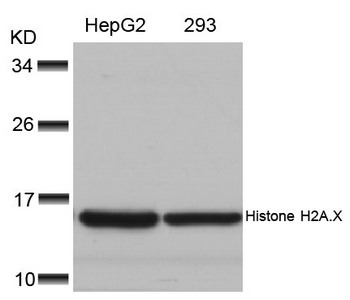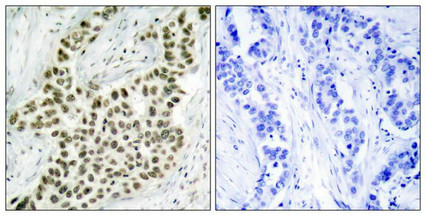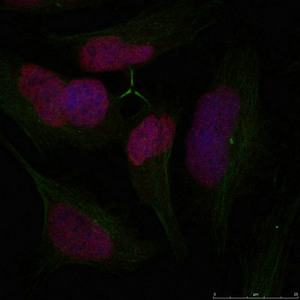
Western blot analysis of extracts from HepG2 and 293 cells using Histone H2A.X(Ab-139) Antibody.
Histone H2A.X (Ab-139) Antibody

CSB-PA954201
ApplicationsImmunoFluorescence, Western Blot, ELISA, ImmunoHistoChemistry
Product group Antibodies
ReactivityHuman
TargetH2AX
Overview
- SupplierCusabio
- Product NameHistone H2A.X (Ab-139) Antibody
- Delivery Days Customer20
- ApplicationsImmunoFluorescence, Western Blot, ELISA, ImmunoHistoChemistry
- CertificationResearch Use Only
- ClonalityPolyclonal
- ConjugateUnconjugated
- Gene ID3014
- Target nameH2AX
- Target descriptionH2A.X variant histone
- Target synonymsH2A histone family member X; H2A.X; H2A/X; H2AFX; H2AX histone; histone H2A.x; histone H2AX
- HostRabbit
- IsotypeIgG
- Protein IDP16104
- Protein NameHistone H2AX
- Scientific DescriptionVariant histone H2A which replaces conventional H2A in a subset of nucleosomes. Nucleosomes wrap and compact DNA into chromatin, limiting DNA accessibility to the cellular machineries which require DNA as a template. Histones thereby play a central role in transcription regulation, DNA repair, DNA replication and chromosomal stability. DNA accessibility is regulated via a complex set of post-translational modifications of histones, also called histone code, and nucleosome remodeling. Required for checkpoint-mediated arrest of cell cycle progression in response to low doses of ionizing radiation and for efficient repair of DNA double strand breaks (DSBs) specifically when modified by C-terminal phosphorylation Yaneva M, et al. (2005) Nucleic Acids Res. 33(16): 5320-5330. Tsukuda T, et al.(2006) Nature. Author manuscript; available in PMC 2006 March 6
- ReactivityHuman
- Storage Instruction-20°C or -80°C
- UNSPSC12352203


